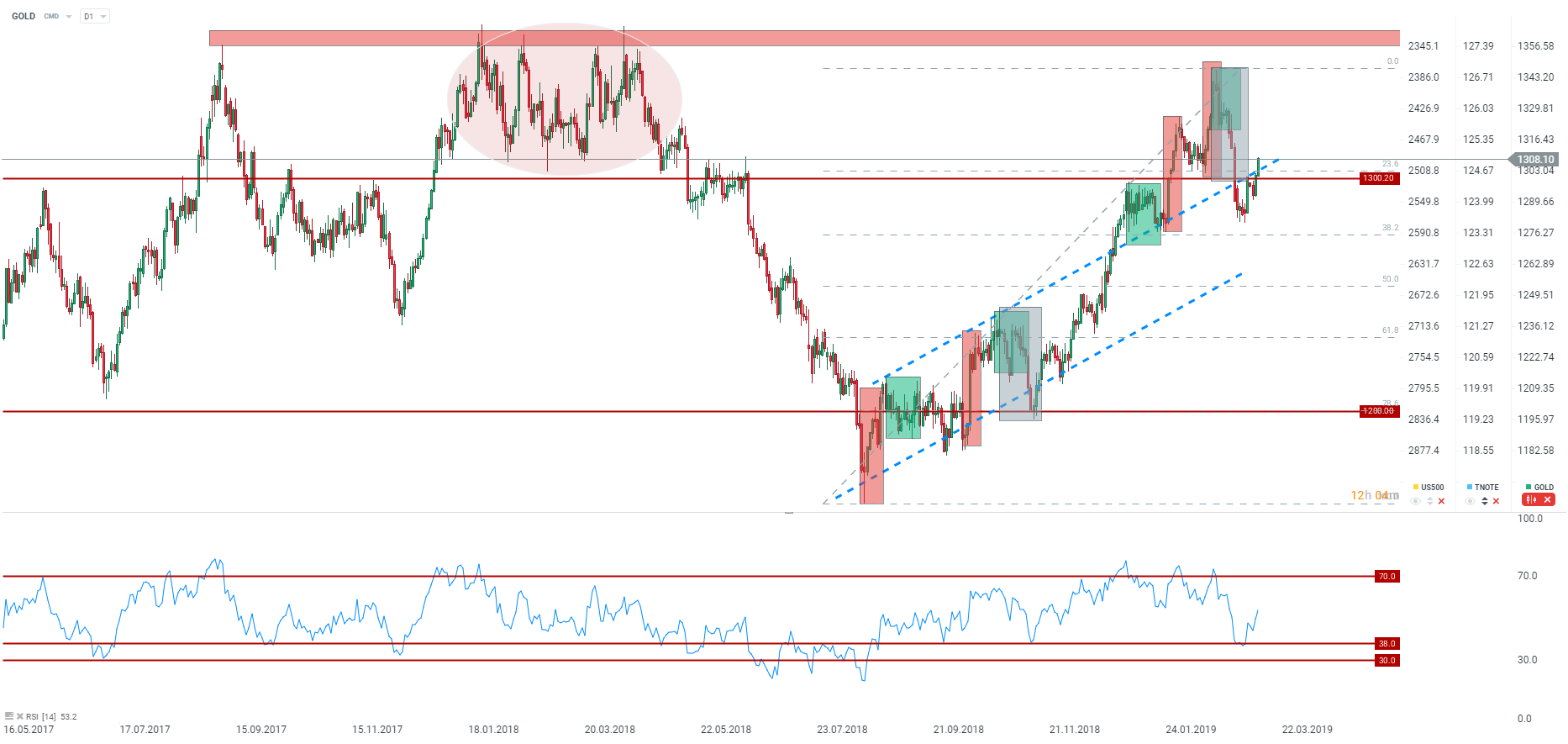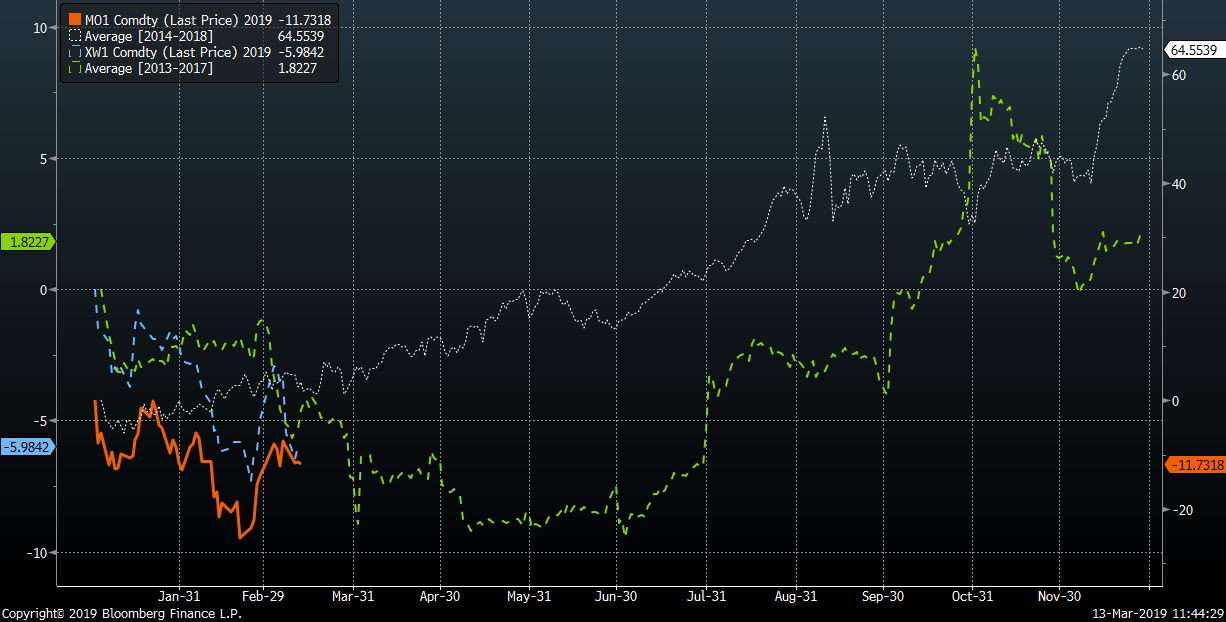Oil:
-
Seasonal analysis suggests US oil inventories could begin falling from the end of this month
-
If a seasonal decline begins sooner, it could be a signal for further moderate rises in oil prices
-
Difficulties in electricity supply in Venezuela may limit oil production despite Russian supplies of paraffin to dilute crude oil
-
Production in Libya may increase to 1.2 mbpd after the Sharara oilfield resumes work
-
Saudi Arabia points to further production cuts in April, the current limits of output could be extended to the second half of this year
-
Low oil output in Mexico, the country could consider pumping more its oil at the cost of imports from the US (a negative factor for prices)
-
China has imported a massive amount of oil (more than 10 mbpd, up 22% YoY and the third largest increase in nominal terms)
-
A low spread between gasoline and oil prices could hinder demand for crude oil from refineries

Oil stocks should begin falling from the end of this month. Source: EIA
Start investing today or test a free demo
Create account Try a demo Download mobile app Download mobile app A low spread between gasoline and oil prices could hinder demand for crude oil from refineries. Source: EIA
A low spread between gasoline and oil prices could hinder demand for crude oil from refineries. Source: EIA
 Oil prices keep rising, albeit some corrective moves should be taken into account. Source: xStation5
Oil prices keep rising, albeit some corrective moves should be taken into account. Source: xStation5
Gold:
-
After a short-term sell-off in gold prices we’ve come back to rises
-
ETF funds’ holdings have ticked up recently
-
If the story from 2017 repeats itself one may expect further rises in prices toward $1400
-
On the other hand, the RSI oscillator suggests a possible consolidation ahead
-
Option market responded positively to the recent fall in the US dollar, based on this measure one may anticipate rises in gold prices over the next 3 months
 Gold prices could be close to the end of the pullback. Rising ETFs’ holdings could point to a bullish scenario. Source: Bloomberg
Gold prices could be close to the end of the pullback. Rising ETFs’ holdings could point to a bullish scenario. Source: Bloomberg
 Based on the RSI oscillator one may expect that gold prices could enter a consolidation. Source: xStation5
Based on the RSI oscillator one may expect that gold prices could enter a consolidation. Source: xStation5
Carbon emission rights (EMISS):
-
Weather forecasts suggest slightly higher temperature over the next two weeks, the level is going to be well above the long-term average
-
EMISS prices are quite closed tied to carbon prices, from this relationship one may expect that EMISS prices could fall further
-
Current EMISS prices seem to be relatively high suggesting that other factors may limit room for further rises
-
EMISS prices look overvalued based on RSI
-
Brexit remains the important topic for EMISS prices, if the Article 50 is extended, it could act positively for EMISS prices in the short-term and negatively in the longer one
 Higher temperature over the coming days and much higher in April could limit further price rises. Source: Bloomberg
Higher temperature over the coming days and much higher in April could limit further price rises. Source: Bloomberg
 Carbon prices should continue falling. The chart above shows that both carbon and EMISS prices have moved in tandem so far this year. Source: Bloomberg
Carbon prices should continue falling. The chart above shows that both carbon and EMISS prices have moved in tandem so far this year. Source: Bloomberg
Wheat:
-
The latest data showed that 55% of US wheat crops were rated as “good or excellent” (51% in Kansas and Chicago)
-
Global wheat stocks are expected to rise more than initially expected (270.5 million tone vs. 267.5 million tone)
-
WASDE report was negative for major grains (higher stocks and lowered exports)
-
Wheat prices have reacted in the vicinity of the crucial technical support, the prices look undervalued in the short-term and based on a seasonal analysis one may look for some upticks in June/July
 Wheat prices tend to rise in June/July. The current price levels seem to be relatively low compared to the 5-year average. Source: Bloomberg
Wheat prices tend to rise in June/July. The current price levels seem to be relatively low compared to the 5-year average. Source: Bloomberg
 If the current candlestick retains its shape until the end of the month it could be a buying signal. Larger price increases could come in the mid-year, however, prices could be under pressure in the weeks to come when data show better wheat conditions due to relatively warm winter. Source: xStation5
If the current candlestick retains its shape until the end of the month it could be a buying signal. Larger price increases could come in the mid-year, however, prices could be under pressure in the weeks to come when data show better wheat conditions due to relatively warm winter. Source: xStation5

